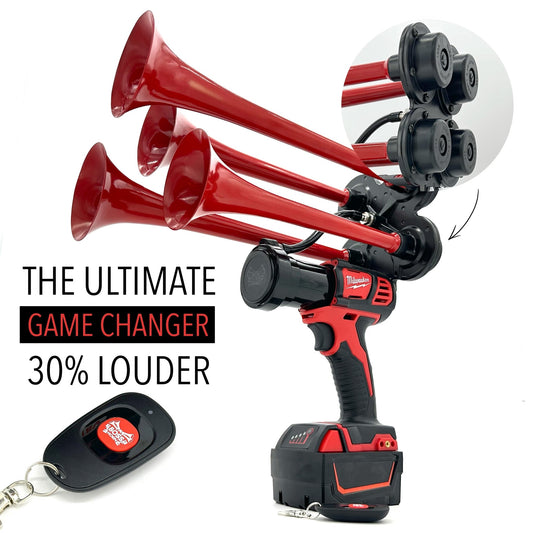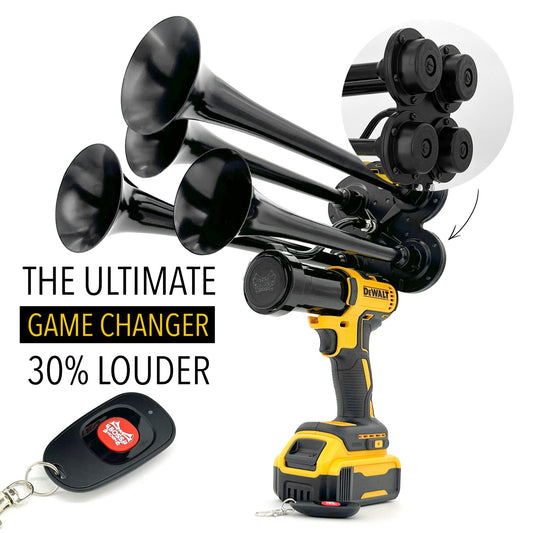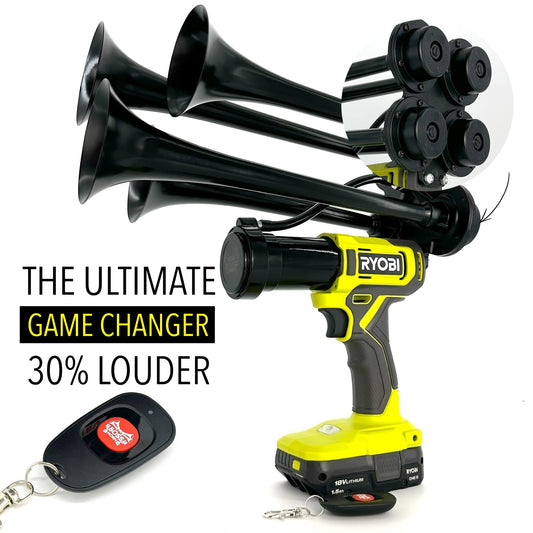Truck horn sounds are an integral part of our roadways, providing crucial communication between drivers and pedestrians. These loud and attention-grabbing noises serve as a valuable safety feature, ensuring that others are aware of a truck's presence and intentions. From the early days of horse-drawn carriages to the present, truck horn sounds have evolved, adopting various tones and patterns to suit different scenarios.
Throughout history, truck drivers have made use of different methods to indicate their presence on the road. In the past, bells and whistles were commonly used, but as technology advanced, the invention of air horns revolutionized the industry. Today, such horns are typically equipped with compressors and pipes that generate the distinct, powerful sound associated with trucks.
The significance of these horn sounds cannot be overstated. In fact, a recent study revealed that nearly 42% of accidents involving trucks could have been avoided if the drivers had used their horns effectively. This staggering statistic underscores the importance of honking to alert others of potential dangers or to signal lane changes. Moreover, truck horn sounds are not limited to simple beeps. Various tones, such as long blasts and short honks, convey different messages and intentions, adding to the complexity of truck-horn communication.
To ensure the seamless integration of these sounds into our daily lives, efforts have been made to mitigate noise pollution. Manufacturers have developed innovative horn designs that reduce the intensity of the sound without compromising its effectiveness. Additionally, initiatives promoting safe driving practices have emphasized education surrounding proper horn usage. By adopting a strategic approach and utilizing horn sounds judiciously, truck drivers can enhance road safety and minimize noise disturbances for everyone.
In conclusion, the evolution of truck horn sounds has played a pivotal role in enhancing road safety and minimizing accidents. These attention-grabbing noises serve as a means of communication between truck drivers and others on the road, providing critical warnings and conveying intentions. With technology advancements and a growing emphasis on safe driving practices, truck horn sounds continue to be an integral part of our roadways, always evolving to strike the perfect balance between effectiveness and minimized noise pollution.
Why are truck horn sounds so loud?
Types of Truck Horn Sounds
Truck horns come in a variety of sounds, each serving a different purpose on the road. Here are some of the most common types:
- Air Horn: The air horn is one of the loudest truck horns available. It produces a deep and powerful sound that can be heard from a long distance. This type of horn is typically used in emergency situations or to grab the attention of other vehicles on the road.
- Train Horn: As the name suggests, the train horn sounds similar to the horn of a locomotive. It is loud and distinctive, making it ideal for heavy-duty trucks that need to alert others to their presence. These horns are commonly used by commercial trucks and trucking companies.
- Electronic Horn: An electronic horn, also known as an electric horn, uses an electric motor to produce sound. These horns are compact and lightweight compared to air horns, making them a popular choice for smaller trucks and personal vehicles. They produce a sharp and clear sound that is easily heard on the road.
- Whistle Horn: Whistle horns have a unique sound that resembles that of a whistle. They are often used by trucks in industrial areas or construction sites to alert workers and other vehicles of their presence. These horns are typically not as loud as air horns but are still effective in getting attention.
Importance of Truck Horn Sounds
Truck horn sounds serve as an essential safety feature on the road. They play a crucial role in alerting pedestrians, cyclists, and other drivers to the presence of a large truck. These sounds help prevent accidents and can potentially save lives. Additionally, truck drivers rely on horn sounds to communicate with each other and indicate their intentions while driving.
Regulations on Truck Horn Sounds
Truck horn sounds are regulated by various traffic laws to ensure they are used appropriately and do not cause unnecessary noise pollution. Different countries and states have specific rules regarding the use of truck horns. For example, in some areas, the use of horns is prohibited during certain hours, such as late at night or early in the morning, to minimize disturbances in residential areas. Truck drivers are required to follow these regulations and use their horns responsibly.
Statistics on Truck Horn Sounds
Here are some interesting statistics related to truck horn sounds:
- According to a study conducted by the National Highway Traffic Safety Administration (NHTSA), horn-related violations were responsible for approximately 6% of all traffic tickets issued.
- In urban areas, it is estimated that truck horn sounds account for around 3-5% of overall noise pollution.
- Studies have shown that the sound of a truck horn can reach up to 110 decibels (dB) at a distance of 50 feet.
- In the United States, the Federal Motor Carrier Safety Administration (FMCSA) requires all commercial motor vehicles, including trucks, to be equipped with a horn that meets specific sound emission standards.
https://youtube.com/watch?v=yXEhyMW-TgQ
FAQ about Truck Horn Sounds
1. What are the different types of alert signals used by commercial vehicles?
There are various types of alert signals used by commercial vehicles to ensure safety on the roads. These signals include:
- Audible alarms
- Visual alerts
- Emergency lights
The most important pieces of information are:
- Audible alarms are used to warn other road users of the presence of the commercial vehicle.
- Visual alerts can include flashing lights or reflective markers to indicate the dimensions of the vehicle.
- Emergency lights are used in cases of emergency or breakdown to warn other road users.
2. How can I differentiate between a commercial vehicle alert sound and a regular truck horn?
Commercial vehicle alert sounds are designed to serve specific purposes and are different from regular truck horns. They may have distinct variations in pitch, duration, and sequence. Additionally, they are usually accompanied by other warning signals such as flashing lights.
The most important pieces of information are:
- Commercial vehicle alert sounds have unique characteristics that differentiate them from regular truck horns.
- Alert sounds are accompanied by visual signals for enhanced safety.
- Commercial vehicles have specific alert sound requirements mandated by regulations.
3. What should I do when I hear an alert sound from a commercial vehicle?
When you hear an alert sound from a commercial vehicle, it is important to take the following steps:
- Remain calm and do not panic.
- Stay alert and be prepared to respond to the situation.
- Give the commercial vehicle enough space and right of way, if necessary.
The most important pieces of information are:
- Maintaining calmness is crucial to prevent impulsive actions that could lead to accidents.
- Being alert allows you to react promptly and safely.
- Giving the commercial vehicle sufficient space helps avoid potential collisions.
4. Are commercial vehicle alert sounds standardized?
Yes, commercial vehicle alert sounds are standardized to ensure consistency and effectiveness. These standards may vary across different regions or countries, but they generally aim to convey a clear message of warning or indication to other road users.
The most important pieces of information are:
- Commercial vehicle alert sounds follow specific standards to avoid confusion on the roads.
- Standardization contributes to effective communication between commercial vehicles and other road users.
- Local regulations may influence variations in alert sound standards.
5. Are there any specific rules or regulations regarding commercial vehicle alert sounds?
Yes, there are rules and regulations in place to govern the use of commercial vehicle alert sounds. These regulations aim to enhance road safety and minimize noise pollution. They may include guidelines on sound levels, permissible durations, and usage in specific situations.
The most important pieces of information are:
- Rules and regulations exist to strike a balance between road safety and noise control.
- Commercial vehicle alert sounds must comply with sound level limits to minimize noise pollution.
- Different situations may require specific usage guidelines for alert sounds.
Conclusion
In conclusion, truck horn sounds play a crucial role in ensuring safety on the road. They serve as effective warning signals to pedestrians, cyclists, and other drivers, alerting them to the presence of a large vehicle nearby. Truck drivers must use their horns responsibly and adhere to regulations governing their usage to avoid unnecessary noise pollution. Additionally, the distinctive sound of a truck horn can evoke a sense of familiarity and create a unique ambience in urban environments. Overall, the truck horn sound is a vital auditory cue that facilitates communication and enhances the overall safety of our transportation systems.














